Students must practice these AP Inter 1st Year Accountancy Important Questions 6th Lesson Subsidiary Books to boost their exam preparation.
AP Inter 1st Year Accountancy Important Questions 6th Lesson Subsidiary Books
Short Answer Questions
Question 1.
Explain the various Subsidiary Books with suitable examples.
Answer:
Separate Books or special books which are maintained to record a particular category of transactions are known as “Subsidiary books”.
The journal is divided into eight subsidiary books. They are :
a) Purchase book: This book records all the goods purchased on credit. Cash purchases and purchases of assets are not recorded in this book.
Whenever goods are bought on credit we receive an invoice from the seller. It is called “Inward Invoice”. It is evidence for recording in purchase book.
b) Sales book: The goods sold on credit are recorded in this book. Cash sales and assets sold for cash or credit are not recorded in this book.
Whenever goods are sold on credit we send an Invoice to the customer. It is called “Out¬ward Invoice”. It is evidence for recording in sales book.
c) Purchase returns book: This book is also known as returns outward book. This book records the goods returned to the suppliers.
When goods are returned to their sellers a ‘Debit Note’ is prepared and sent to the suppliers along with goods.
![]()
d) Sales returns book: This book is also known as returns inward book. This book records the goods returned by the customers.
When the sellers receive goods back from the customer along with a debit note, then he prepares a credit note, and sends to the customer. ,
e) Cash book: Cash book is used for recording all cash transactions i.e. cash receipts and cash payments either in cash or by cheque are recorded in this book.
f) Bills receivable book: This book is used to record all the bills received from the customers for the amount due. It contains details of acceptor of the bill, its due date, date bill, the amount due, etc.
g) Bills payable book: If the goods are purchased on credit and bills are accepted for the due amounts, all these bills payable are recorded in this book. It contains the amount due, date of bill, place of payment, due date, etc.
h) Journal proper: This book is used to record only those transactions, which cannot be recorded in any one of the seven subsidiary books side above.
Question 2.
Give the advantages of subsidiary books.
Answer:
Subsidiary Book Advantages:
a) Saving of Time: No need of writing the Journal Entries. Transactions are directly entered into their respective journals.
b) Division of Work: By entrusting different Subsidiary Books to different persons, division of principle can be implemented.
c) Easy Recording: Transactions can be recorded very fast and easy.
d) Improves Efficiency: Accounting work will be done efficiently by allotting work to different experts who prepare the Special Books.
e) Detection of Errors: Since Separate Books are maintained to record a particular set of transactions, errors can be easily noticed.
![]()
Question 3.
Explain about the Purchases book and draw the pro forma of it.
Answer:
This book records all the goods purchased on credit. Cash purchases and purchases of assets are not recorded in this book.
Whenever goods are bought on credit we receive an Invoice from the seller. It is called “Inward Invoice”. It is evidence for recording in the purchase book. It is numbered serially and filed in a separate file.
Proforma of purchase book:
Purchase book contains five columns, such as Date, Particulars, Invoice No., L.F.Nb. and Amount
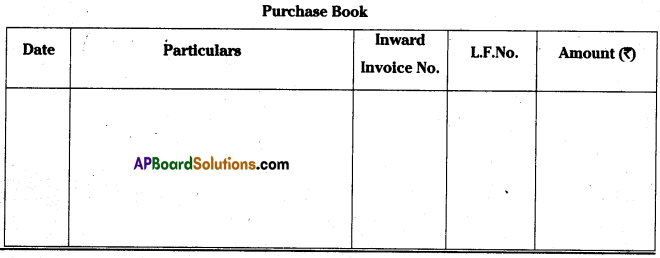
Question 4.
Explain about Sales book and draw the pro forma of it.
Answer:
The goods sold on credit are recorded in this book. Cash sales and assets sold for cash or credit are not recorded in this book.
Whenever goods are sold on credit we send an invoice to the customer. It is called “Outward invoice”. It is evidence for recording in sales book. It is serially numbered and kept in a separate file.
Proforma of sales book:
Sales book contains five columns, such as Date, Particulars, Invoice No., L.F.No. and Amount.
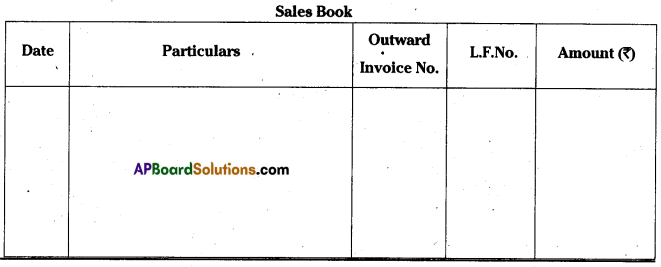
Question 5.
Answer the following in not more than 5 lines. [Mar. 17 – A.P.]
a) Invoice
b) Debit Note
c) Credit Note
d) Tradp Discount
e) Journal Proper
Answer:
a) Invoice:
It is the document prepared by the supplier of goods with all the details like quantity, price discount offered and other terms and conditions. This is also known as “Inward Invoice”.
b) Debit Note: [May 2022, Mar. 2019 – A.P, Mar. 2018 – T.S.]
If goods are returned to the supplier, a debit note or letter is sent along with goods, informing the supplier about the debit given to his account for the value of the goods returned. This note is known as debit note.
c) Credit Note:
If the customer returned the goods, a credit note is sent to him by the traders informing the customer that his account has been credited with the value of the goods returned.
d) Trade Discount:
It is a reduction in the catalogue price of an article. This is given by the wholesaler to the retailer to enable him to sell at a catalogue price and make a profit. It is not entered in books.
e) Journal Proper: [May 17 – A.P.]
This book is used for recording only those transactions which cannot be recorded in any one of the seven subsidiary books said above.
Examples: Opening entries, closing entries, adjustment entries, transfer entries.
Problems
Question 1.
Record the following transactions in the purchases book.
| 2013 | Rs. | |
| March 4th | Purchased goods from Madhu | 2500 |
| 6th | Purchased goods from Kalyan | 6500 |
| 11th | Bought goods from Ashok | 5000 |
| Trade Discount 10% | ||
| 14th | Purchased goods from Praveen | 1300 |
| 17th | Purchases | 4000 |
| 19th | Purchased goods from Gopal | 1200 |
| 25th | Purchased goods from Joshi | 1800 |
Hint 1: For transaction dated on 11th calculate trade discount @ 10% on Rs. 5,000/- i.e. 5000 x 10/100 = 500, and take net purchases as 5000 – 500 = 4500.
Hint 2: Transaction dated 17th March is a cash transaction. So, it is not to be taken in purchase book.
Answer:

![]()
Question 2.
Prepare Purchases Book from the following:
2013 — Rs.
Jan 1st — Purchased goods from Akshay — 5,000
” 4th — Goods purchased from Dileep — 4,000
” 10th — Goods purchased from Monoj (Trade Discount 10%) — 10,000
” 12th — Cash Purchases — 6,000
” 15th — Purchased Goods from Mahesh — 3,000
” 20th — Purchased Goods from Anil — 7,000
Hint 1: For transaction dated on 10th calculate discount @ 10% on 10,000/- i.e. 1,000 and takes net purchases as 10,000 – 1,000 = 9,000.
Hint 2: Transaction dated on 12th is a cash transaction. So, it is not entered in the purchases book.
Answer:
Purchases Book

Question 3.
Record the following in Purchases Book:
2012
March 1st — Purchase goods on credit from Chand traders Invoice No. 301. 120 reams of white paper @ 15 per ream 60 dozen ink pots @ 25 per dozen
8th — Purchased from Gupta traders Invoice No. 403 10 Drawing boards @ 30 each 40 Notebooks @ 20 each
10th — Purchased goods from Goyal and Company for cash 3,000.
15th — Purchased goods from Ankit Rs. 10,000 as per Invoice No. 450.
Hint 1: Transaction dated on March 1st Net Purchases amount is to be calculated as, (120 x 15) + (60 x 25) = 1800 + 1500 = 3300
Hint 2: Transaction dated on March 8th Net Purchases amount is,
(10 x 30) + (40 x 20) = 300 + 800 = Rs. 1100
Answer:

Question 4.
Enter the following in Purchase Book and Purchase Returns Book: [Mar ’20, ’19 (AP&TS)]
| 2012 (2019) | Rs. | |
| July 1st | Purchased goods from Mohan | 8,000 |
| 5th | Purchased goods from Rajesh | 6,000 |
| 10th | Purchased goods from Ravi | 5,000 |
| 12th | Returned goods to Rajesh | 600 |
| is”‘ | Purchased goods from Hari | 4,000 |
| 20th | Goods returned to Ravi | 300 |
Answer:

![]()
Question 5.
Prepare Sales Book [May ’17 (AP)]
| 2013 | Rs. | |
| Aug. 1st | Goods sold to Shekar | 1800 |
| 10th | Sold goods to Srinivas | 2000 |
| 14th | Sales | 800 |
| 16th | Sold goods to Gopal | 4000 |
| (Trade Discount 5%) | ||
| 20th | Sold furniture to Krishna | 500 |
| 24th | Sold goods to Mahender | 3000 |
Hint 1: Trade discount is 4000 x 5/100. Net sales = 3,800.
Hint 2: Transaction dated on 14th is a Cash transaction.
Answer:
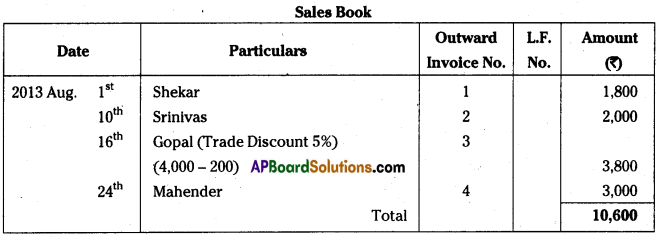
Question 6.
Enter the following transactions in Sales Book and prepare Ledger.
2013 — Rs.
April 1st — Sold goods to Mahi — 5000
Invoice No: 102
4th — Goods sold to Naveen — 2000
Invoice No: 128
10th — Sold goods to Naidu — 2500
Invoice No: 135
15th — Sold goods to Suman — 7000
Invoice No: 142
18th — Sold goods to Prashanth — 8000
Invoice No: 145 (Trade Discount 10%)
20th — Sold goods to Sainath for cash — 4000
Hint 1: For the transaction dated on 18th calculate trade discount
i.e. 8000 x 10/100 = 800, net sales = 7200.
Hint 2: The transaction dated on 20th is a cash transaction.
Answer:
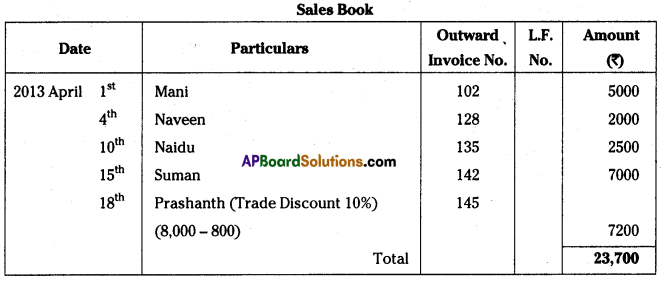
Ledgers:
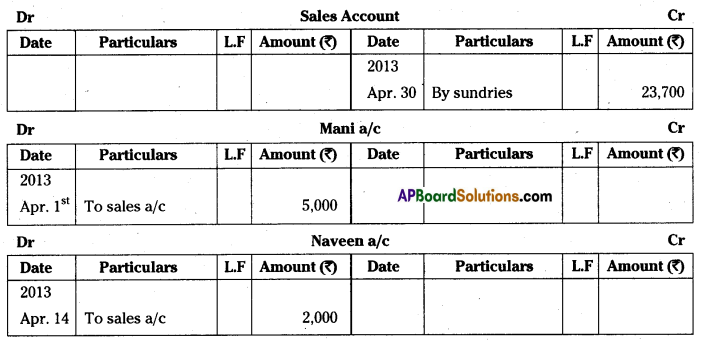

Question 7.
Prepare Sales Book and Sales Returns Book from the following. [Mar. 2018 -A.P. & T.S.]
2013 — Rs.
May 1st — Sold goods to Rahul — 6500
3rd — Sold goods to Manish — 6000
8th — Returned goods by Rahul — 700
11th — Sold goods to Raj Kumar — 12000
14th — Sold goods to Bhanu — 11000
17th — Returned goods from Raj Kumar — 2000
21st — Sold goods to Anand — 9000
Answer:

![]()
Question 8.
Record the following transactions in Proper Subsidiary Books.
2014 — Rs.
Feb. 1st — Purchased goods from Pavan — 14000
6th — Sold goods to Sandeep — 8000
10th — Sendeep returned goods — 500
11th — Purchased goods from Giri — 10500
12th — Sold goods to Arjun — 6500
13th — Goods returned to Giri — 500
15th — Sold goods to Charan — 3500
18th — Goods returned by Arjun — 300
20th — Purchased goods from Jairam — 7500
25th — Returned goods to Jairam — 400
Answer:

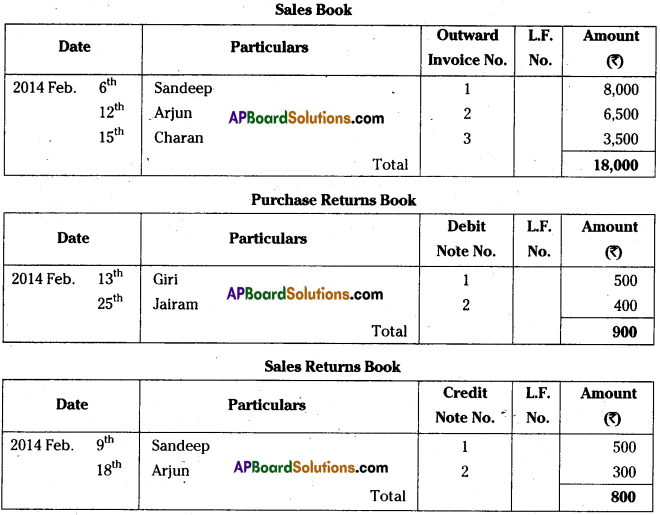
Question 9.
Enter the following transactions in the related Subsidiary Books.
2013 — Sep.
1st — Purchased goods from Siva — Rs. 2000
5th — Purchased goods from Prasad — 4500
7th — Sold goods to Rahim — 9000
8th — Goods returned to Prasad — 500
10th — Purchased goods from Vinod (Trade Discount 10%) — 15000
14th — Sold goods to Pradeep — 12000
16th — Goods returned by Pradeep — 1000
18th — Goods purchased for cash — 6000
20th — Sold goods to Praneeth (Trade discount 5%) — 3000
24th — Purchased goods from Vijay — 3700
26th — Sold old machinery — 1400
27th — Bought goods from Venkat (Trade discount 15%) — 8000
29th — Returned goods to Vijay — 200
Hint 1: For transaction dated on 10th Trade discount is 15000 x 10/100 = 1500
Net purchases = 13500
Hint 2: The transaction dated on 18th is a cash transaction.
Hint 3: For transaction dated on 20th Trade discount is 3000 x 5/100 = 150
Net sales – 2850
Hint 4: Transaction dated on 26th is to be entered in the journal proper.
Hint 5: For transaction dated on 27th Trade discount is 8000 x 15/100 = 1200
Net sales = 6,800
Answer:
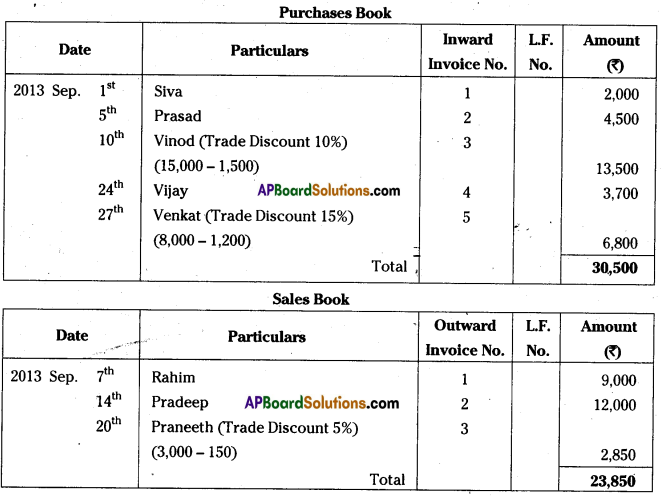
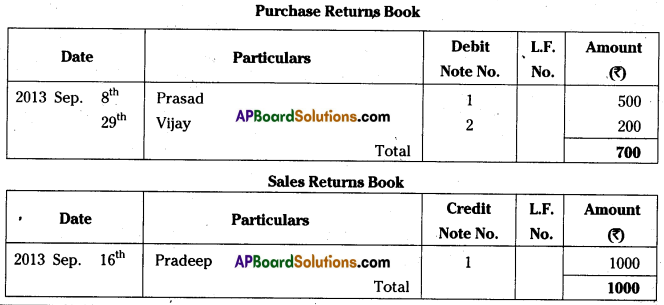
![]()
Question 10.
Prepare Purchases Book.
2014 — Rs.
Jan. 1st — Purchased goods from Jaipal — 6200
6th — Purchased goods from Mahipal — 4000
9th — Purchased goods from Gopal — 2800
10th — Purchased goods from Bhoopal — 12,800
(Trade discount Rs. 800)
12th — Purchased goods from Rampal — 10000
Answer:
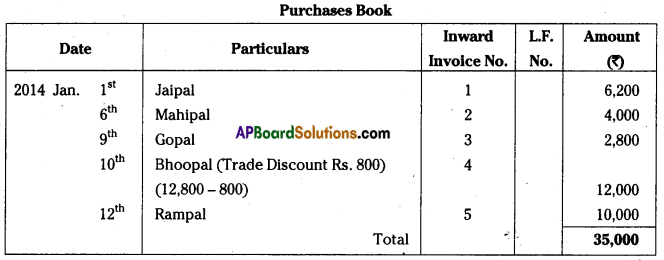
Question 11.
Enter the following transactions in Purchases Book and post them in Ledger.
2013 — Rs.
Dec. 1st — Goods purchased from Sohan — 9000
3rd — Purchased goods from Rohan — 4000
5th — Goods purchased from John — 3000
8th — Purchased goods from Shoban — 6000
10th — Purchased office furniture from Anil — 13000
14th — Purchased goods from Aman — 3500
15th — Purchased goods from Mohan Purchases Book — 1000
Answer:
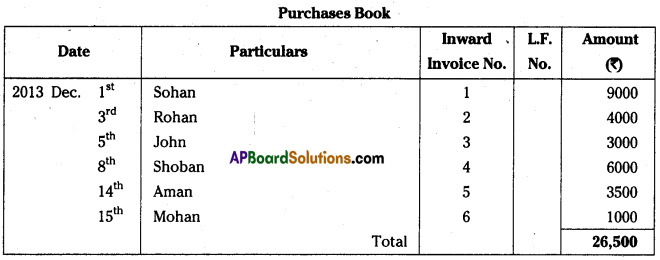
Ledgers:

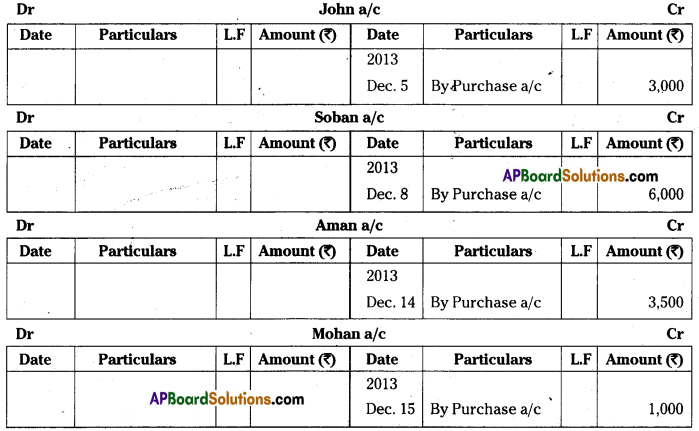
Question 12.
Record the following in Sales Book and Sales Returns Book.
2013 — Rs.
June 2nd — Sold goods to Larthik traders — 1500
4th — Sold goods to Gupta traders — 9200
5th — Goods returned from Karthik traders — 200
8th — Sold goods to Manish traders — 2800
10th — Return inwards from Gupta traders — 1500
13th — Sold goods to Jayanth traders — 8600
15th — Goods sold to Karthikeya traders — 2400
Answer:

Question 13.
Enter the following transactions in Proper Subsidiary Books: [May 17 -A.P.]
2013 — Rs.
Nov 5th — Purchased goods from Arun — 5800
8th — Purchased goods from Tarun — 9000
10th — Returned goods to Tarun — 1000
15th — Purchased goods from Varun — 11000
17th — Purchased machinery from Jagan — 5000
19th — Purchased goods from Karun — 10000
(Trade discount 15%)
23rd — Return outwards to Varun — 1000
Hint: Transaction dated Nov. 19th trade discount 15% of 10000 i.e., 10000 x 15/100 = 1500 is to be deducted from purchase amount Rs. 10000 Net purchases 10000 – 1500 = 8500
Answer:
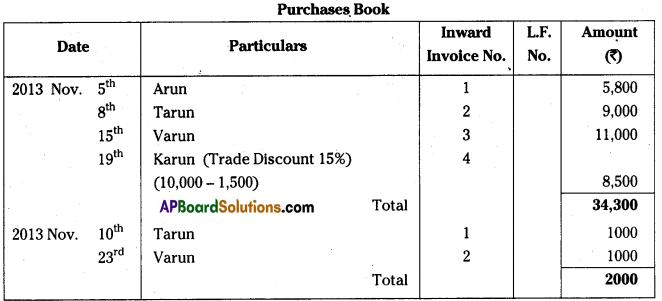
![]()
Question 14.
From the following transactions prepare Sales Book and Sales Returns Book.
1998 — Rs.
Jan 1st — Sales to Jayanthi Traders
4th — Sales to Rao
12th — Sales to Giri & Co.
15th — Returns from Jayanthi Traders
21st — Returns from Giri & Co.
Answer:
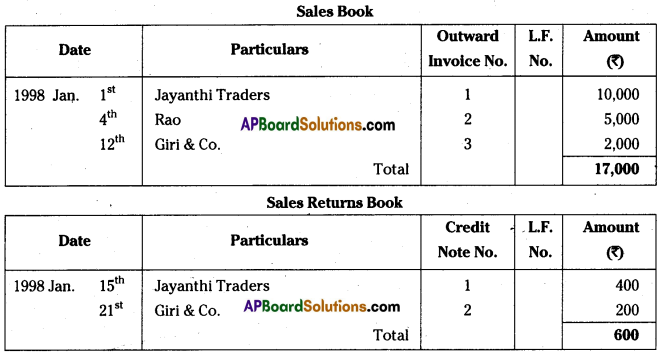
Question 15.
Enter the following transactions in proper Subsidiary Books. [IPE. Mar. 14]
2012 — Rs.
Jan. 1st — Purchased goods from Varsha — 10,500
2nd — Purchased goods from Saritha — 5,000
5th — Returned goods to Varsha — 300
8th — Purchased goods from Bhavana — 2,000
10th — Returned goods to Saritha — 500
15th — Purchase from Meghana — 3,300
Answer:


![]()
Question 16.
Record the following transactions in proper Subsidiary Books. [May 2022]
2020 — ?
February 1 — Sold goods to Siva — 10,000
” 3 — Sold goods to Raju — 7,500
” 9 — Goods returned by Siva — 500
” 11 — Sold goods to Prasad — 2,500
” 14 — Sold goods to Charan — 5,000
” 17 — Goods returned by Prasad — 400
” 25 — Sold goods to Jaya — 6,000
(Trade discount 10%)
Answer:

